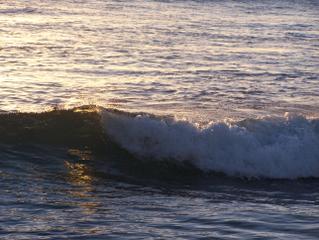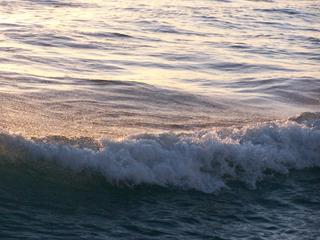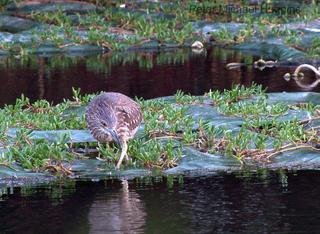Surfing at Ala Moana 1

A chronicle of my attempt to learn this most Hawaiian of sports.
Episode One - Disappointment
When the day finally arrived I was unprepared. The sun had hidden himself behind whitened clouds and the winds were up, blowing onshore in a steady breeze. Three of us walked down to the beach but only two entered the water. There was only one board between the two of us. Kurt had said we could share just one, and that he would teach me to surf.
When you’re an English city boy living in
As it happens we have chosen a local boy’s favourite spot; this is no tourist
By the time the first small breakers begin to reach us I have several streaks of anemone bristle stuck in each foot. These are only slightly poisonous, less than a bee sting but uncomfortable enough. I feel as if any big waves will toss me over and dash me on the coral. I am still having fun though, because I can almost touch it now, that fabled dream, of which the Beach Boys sang so sweetly. Kurt is having trouble with the board. In fact I am a good thirty feet ahead of him now and he looks to have stopped paddling. I am beginning to roll in the surf.
I am torn between the board and the open ocean. I sense Kurt’s defeat and I realise this means we are going back. The disappointment in my heart is an ache, like a sadness, but as we paddle (swim) home I recall that the waves will persist into tomorrow. I can come out on my own tomorrow. One man, one board. The pain in my heart is joined by the strain in my shoulders, but I feel neither as I think about the future.

Episode Two - Do not underestimate the power of street knowledge
The beach is three blocks from our place. At
I have to cross through a park before I get to the beach. The park is a sculptured landscape; there is a man-made stream with stuccoed bridges lined with trees, there are picnic tables in wooded stretches, and there are colonnades, where old men sit to talk story. The park is built for pleasure, and it opens onto the beach. Along the last stretch of grass live the Banyan trees; great elders which hang their wispy beards on the ground. Underneath live the transients, or what I would call hobos, or tramps, on tarpaulin beds and cooking on stoves.
The beach is a sudden brightness, the sand is so white it hurts the eyes. Today is a beautiful day. It is baking as I approach the lifeguard hut, thinking of introducing myself:
“Hello” I say. “How’s it going?”.
“Alright” says the lifeguard, “You got enough wax on that thing?”, he indicates my board. I have no idea whether or not I have enough wax on it.
“Yeah I think so" I say, "this is my first time out on a board”. I reckon that by saying this I will appeal to his better nature, and prompt him to take special care of me. It works! He makes an important point straight away:
“Well it’s OK out there, you see that cone on the reef?” I look out to where he points, in the glare I am a bit lost, “There, right in front of us”, he says. I spot the cone, about 150 yards from where Kurt and I had paddled out the day before.
“Oh yes”, I say.
“That’s where you should paddle out, it’s the deepest part of the reef”, I feel a spark of realisation as he points to the left where Kurt and I had paddled out the day before, “anywhere in that direction you’ll get cut up on the coral”. OK, I think to myself, so that explains what went wrong yesterday!
“Oh yeah, and then go out to the breakers?” I suggest,
“Yeah, you see where those guys are now, there it’s a good break today. Go straight out past the reef and then go around. Yeah it looks shoulder high so it should be OK”. I make as if to leave. “I don’t know if you’re regular or goofy” admits the lifeguard “but there’s a left and a right breaker out there”. I don’t immediately know what he’s talking about, but it seems important. Then from a dim memory of a Nintendo snowboarding game I recall that goofy means left-footed.
“Oh I’m regular”, I say
“OK well you should be OK”
“Thanks” I say, “catch you later”.
Spotting another cone about twenty yards up the beach, I realise that this whole thing has been organised already. The cone here indicates where the shore is least rocky, and the cone on the reef indicates where the reef is safest to cross. I am grateful to be in such a well organised place.
Paddling out today is a surprise. I can’t stay on the board. In the end I find that my legs are the problem, but if I grip the edge of the board with my feet, I am OK. I travel pretty fast on this thing, but I don’t know how deep in the water the front of the board should be and when I experiment I fall off. Before I cross the reef I stop and practise a bit more in the relative calm of the lagoon, sitting and lying on the board, paddling, falling off and climbing on.
I don’t catch any waves all afternoon. I watch the local boys having fun and I follow their movements in the waves. I feel a sense of togetherness with another haole out there today, clearly not catching anything, and clearly jealous of the local boys. Two children on boogie boards catch huge waves and travel at amazing speeds, laughing, as I look on. They can’t be any older than twelve or thirteen.
Washing down my board and catching my breath, sitting next to the park after two hours in the sea, I am exceedingly calm and happy to be in this beautiful place. Turning to the man washing down his board I ask:
“Catch anything out there?”
“Oh yeah it’s good out there today I caught plenty. How about you?” he asks.
“Oh well it’s my first time out on a board so I didn’t do so good” I admit.
“Yeah I saw you paddling around out there. You gotta get more on your board, your whole body on the board, you’re using it more like a boogie board”
“Yeah” I agree,
“Just get used to being on the board. Stay in the white water and let the waves take you so you know how it feels. Forget the waves, stay in the white water”
“OK cheers, thanks for the advice. I’m Pete by the way”
“Jeff”, he says, and waves me chuckas.
On the way home I realise I look pretty stupid in my straw hat, but that’s OK here. Hawaiians are used to stupid haole making mistakes in the waves and living indolent lives on the islands. The spirit of aloha is still alive and




